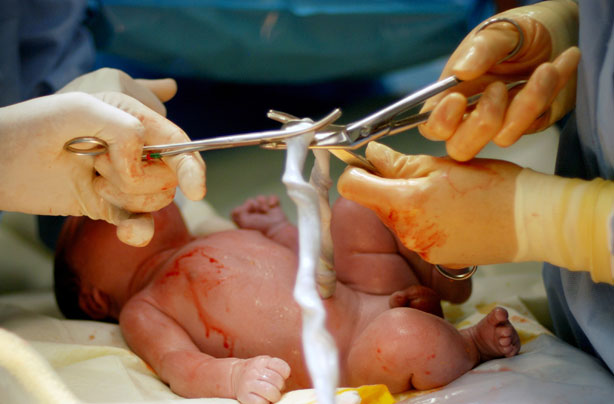What is delayed cord clamping?
Everything you need to know about delayed umbilical cord clamping


Delayed umbilical cord clamping has gathered popularity in recent years, with many believing it helps babies receive increased essential nutrients in the first few moments of their lives.
When it comes to the type of birth you're considering, there are many things to think about. But would you be tempted to think about delayed cord clamping? We take a look at what it's all about.
What is delayed clamping?
The practice sees doctors and midwives wait for at least a couple of minutes before clamping and removing the baby's cord, which is attached to the mother's placenta. Traditionally this has been done almost instantly because doctors believed it lowered the risk of mothers potentially haemorrhaging after giving birth. However, according to a study by Cochrane Library of medical researchers the risk remains the same for immediate and delayed clamping.
Why is delayed clamping considered beneficial?
Research has shown that holding off from removing the cord for at least two minutes (or until the cord has stopped pulsating) could potentially boost new-borns' iron levels.
The Royal College of Midwives published research in a 2015 report that says, 'Immediate cord clamping reduces the flow of blood to the baby and can deprive the baby of iron. Iron deficiency in the first few months is associated with neurodevelopmental delay.
In healthy [full] term babies the evidence supports deferred clamping as this appears to improve iron stores in infancy. This is in line with NICE guidance. Once delivered, the baby can be placed on the mother's abdomen or chest with the cord intact and the timing of clamping should be recorded.'
Speaking to the Guardian, Belinda Phipps, chief executive of the NCT, explained that she thought widely practiced delayed clamping could reduce the number of new-borns who need specialist care after delivery. 'When a baby is born around a third of the baby's blood is still in their cord and placenta, and clamping the cord early reduces the iron available to the baby. It is becoming increasingly clear that things need to change', she said.
GoodtoKnow Newsletter
Parenting advice, hot topics, best buys and family finance tips delivered straight to your inbox.
What are the potential negatives to delayed clamping?
In some cases, however, delayed clamping wouldn't be advised, and should be judged by clinical assessment for each case. For instance, if a baby needs immediate resuscitation, or the mother is losing a lot of blood it may be necessary to remove the cord immediately. There is also some research to say that delayed clamping slightly increases the chance of jaundice in new-borns.
Would you consider delaying the clamping of your baby's umbilical cord? Let us know in the comments below.

Rosie is an experienced food and drinks journalist who has spent over a decade writing about restaurants, cookery, and foodie products. Previously Content Editor at Goodto.com and Digital Food Editor on Woman&Home, Rosie is well used to covering everything from food news through to taste tests. Now, as well as heading up the team at SquareMeal - the UK's leading guide to restaurants and bars - she also runs a wedding floristry business in Scotland called Lavender and Rose.